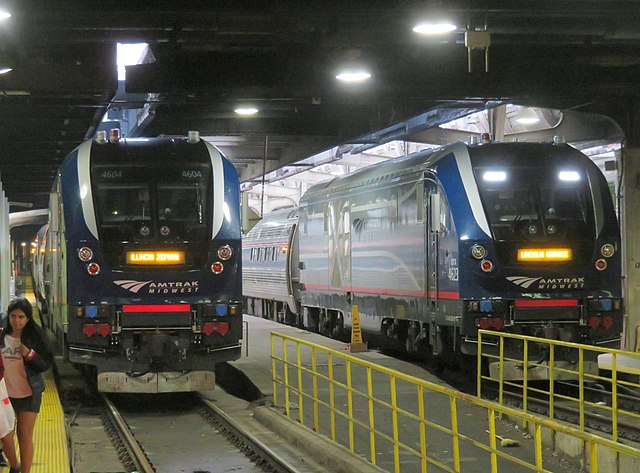What does $2 billion and fourteen years buy? In 2009, Congress appropriated $8 billion for high-speed rail, and the Obama administration gave Illinois more than $1 billion of that to speed up trains between Chicago and St. Louis. The state of Illinois provided its own funds, bringing total spending up to $2 billion. Now, fourteen years later, Amtrak is proud to announce the results: the top speed of trains in the corridor will increase from 90 to 110 miles per hour.
New locomotives purchased to pull the not-so-high-speed trains in the Midwest. Photo by Pi.1415926535.
Don’t get too excited. Although 110 miles per hour is 22 percent faster than 90 miles per hour, trains in the Chicago-St. Louis corridor will average just 5 percent faster, or 2 miles per hour, than under the old schedules. Under Amtrak’s old timetables, the fastest of five trains in the corridor averaged the 284-mile trip at 55.7 mph while the slowest went 52.0 mph, with the average of all five being 54.0. In late July, the new schedule the fastest train to 59.6 mph, the slowest to 53.9, and the average of all five to 56.8.
On average, the new schedules save Chicago-to-St. Louis travelers 16 minutes when compared with the old schedules. But even with a top speed of 110 mph, it’s still not competitive with driving. According to Google maps, a drive from Chicago to St. Louis takes 4 hours and 37 minutes, plus goes from door to door at any time of day. The fastest Amtrak train under the new timetables takes 4 hours and 46 minutes, another takes 4 hours and 59 minutes, and all the others take 5 hours or more, and none of them take you to your final destination.
Amtrak’s announcement was more about safety than a brag about high-speed trains. “Motorists, pedestrians, and bicyclists should always use caution on this important rail corridor,” warned Amtrak, “as our trains are faster than they can appear and are quieter than ever.” Why are they quieter: did they lose their horns?
In any case, Amtrak must be watching what happened when Brightline increased the speed of its trains in Florida. This quickly made it the most deadly rail line in the United States. It has already killed at least two people this month, including a woman on June 2 and a man on June 6. Amtrak doesn’t want the Chicago-St. Louis corridor to follow Brightline’s example, but a press release plus “additional warning signs and fencing . . . in selected areas” will probably not be enough to keep the death count down.









Not scraping the top intellectual barrel. This could have been avoided if the conductor has just slowed down and swerved out of the way… (LOL)
she was probably on the phone or had headphones on. I see bikers, cyclists and pedestrians get hit by a car etc.. stay away from your phone when you are on the streets, it doesn’t matter if you are walking, riding or driving.Population control working at its finest.
The lady hit was par for course with Brightline. Ya, she ignored the gates but Brightline have been too cheap to install proper full gates at that crossing. FRA requirements shouldn’t be based on speed but also if it’s an urban area.
As for the Lincoln Service, I don’t know what folks are doing. On average it’s going to cost you $300 to drive to St. Louis and back from Chicago. Tickets on Lincoln service for this 4th of july week can be had for $150 for a family of 4.
They spent a billion dollars to save 16 minutes.